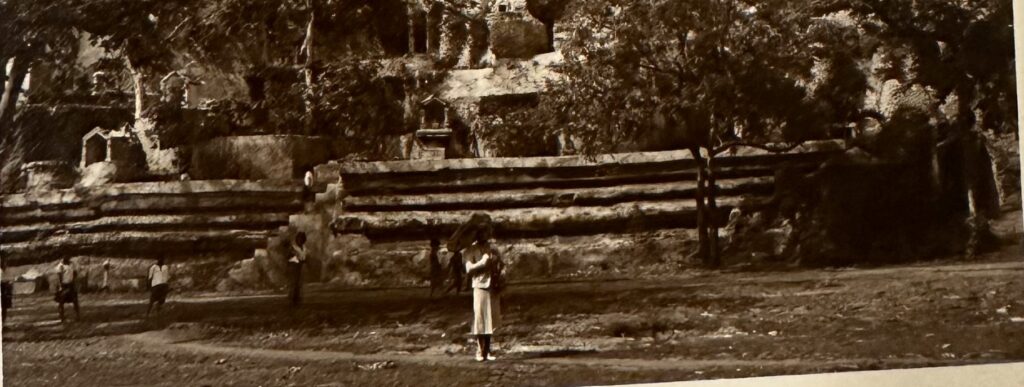Sumatra- Siam, 1934
This photo was taken by a European couple during their travel to Sumatra and Bangkok in 1934. This photo was part of an attractive album with one hundred and eighty lively well-executed vernacular photos. The couple travelled to Sumatra (then part of the Dutch East Indies) and the kingdom of Siam (Thailand after 1939) just a few years before the beginning of WW2. About eight five photos illustrate their journey around western and northern Sumatra, from the port of Padang to Medan on the island’s north-eastern coast. The source of this photo was from the rare picture catalog in the CU library. The temple in the photo is called Wat Saket (also the new title to my essay).
Wat Saket

The image shows the temple of Wat Saket Ratcha Wora Maha Wihan in the 1930s. In the picture the lady is standing in front of the temple with her umbrella. It looks like the husband took the picture of her with the temple in the background. The lady seems to be dressed in the traditional European dress they wore back in the day. The roads that lead to the temple look like a pedestrian path. It shows that even without the urbanization in Bangkok these mega temples were being built. Even though Bangkok was never colonized, other SEA countries were still under colonization under this period. So, it makes sense for the colonizers to come and explore this beautiful city.
Behind her, the bottom of the temple seems to have walls reinforcing the temple. There are also some other individuals who look like Thai nationals. Looks like most people wore white and black clothes but it could also be because of the picture quality. But since colored fabrics were expensive back in the day it would also be safe to assume most people wore black and white clothing. Also due to the lack of pixels and older camera this almost looks like a painting. This also shows how hot it was during that time as the Thai men in the back have shirts and what looks like a cloth around them to keep them cool whereas the European lady is fully clothed with her umbrella. This shows the cultural difference between the two countries. Since, Europe isn’t tropical country most women wore dresses on the daily basis, and Thai being a tropical country most people wore loose clothes to keep them cool.
The temple itself is one of the oldest temples dating back to the Ayutthaya era, which lasted until 1767. The temple was restored when King Rama became the first ruler of the Rattanakosin Kingdom. He ordered the temple to be restored and renamed it to Saket Ratch Wora Maha Wihan, or Wat Saket for short. The Wat Saket was used to cremate the deceased who were too poor to afford a funeral or cremation. The temple sits on top of a hill that requires 318 steps climb up the hill. As you can see in the picture the steps wrap around the temple. On top of the temple is a gilded stupa that contains relics of Buddha, that were brought from India.
This picture shows how high the temple was. It was one of the highest points in Bangkok since recently. It had a great view of the whole city. There are plenty of trees and greenery around the temple. The walls for the stairs look like they were built with bricks. The temple has windows on all sides to get a great view of the city.
(It wouldn’t let me upload the pictures)
The above pictures were taken during November 2022, during my visit to Thailand. The picture on the left is the real temple of Wat Saket that is in the base of the temple. It’s not visible in the picture that I picked. The one on the right is the current picture of the temple. The difference is the temple is now in the center of a lot of buildings and other temples. This shows the urbanization in Bangkok.
Sources
https://www.renown-travel.com/temples/wat-saket.html